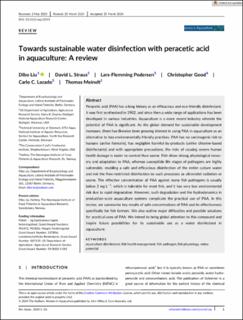| dc.contributor.author | Liu, Dibo | |
| dc.contributor.author | Straus, David | |
| dc.contributor.author | Pedersen, Lars Flemming | |
| dc.contributor.author | Good, Christopher | |
| dc.contributor.author | Lazado, Carlo C. | |
| dc.contributor.author | Meinelt, Thomas | |
| dc.date.accessioned | 2024-04-05T12:55:57Z | |
| dc.date.available | 2024-04-05T12:55:57Z | |
| dc.date.created | 2024-04-03T20:48:33Z | |
| dc.date.issued | 2024 | |
| dc.identifier.issn | 1753-5123 | |
| dc.identifier.uri | https://hdl.handle.net/11250/3125125 | |
| dc.description.abstract | eracetic acid (PAA) has a long history as an efficacious and eco-friendly disinfectant. It was first synthesised in 1902, and since then a wide range of applications has been developed in various industries. Aquaculture is a more recent industry wherein the potential of PAA is significant. As the global demand for sustainable development increases, there has likewise been growing interest in using PAA in aquaculture as an alternative to less environmentally friendly practices. PAA has no carcinogenic risk to humans (unlike formalin), has negligible harmful by-products (unlike chlorine-based disinfectants) and with appropriate precautions, the risks of causing severe human health damage is easier to control than ozone. Fish show strong physiological recovery and adaptation to PAA, whereas susceptible life stages of pathogens are highly vulnerable, enabling a safe and efficacious disinfection of the entire culture water and not the flow-restricted disinfection by such processes as ultraviolet radiation or ozone. The effective concentration of PAA against many fish pathogens is usually below 2 mg L−1, which is tolerable for most fish, and it has very low environmental risk due to rapid degradation. However, such degradation and the hydrodynamics in production-scale aquaculture systems complicate the practical use of PAA. In this review, we summarise key results of safe concentrations of PAA and its effectiveness specifically for fish farmers. We also outline major difficulties and possible solutions for practical uses of PAA. We intend to bring global attention to this compound and inspire future possibilities for its sustainable use as a water disinfectant in aquaculture. | |
| dc.description.abstract | Towards sustainable water disinfection with peracetic acid in aquaculture: A review | |
| dc.language.iso | eng | |
| dc.subject | Fiskehelse og velferd | |
| dc.subject | Fish health and welfare | |
| dc.subject | Desinfeksjonsmidler | |
| dc.subject | Disinfectants | |
| dc.title | Towards sustainable water disinfection with peracetic acid in aquaculture: A review | |
| dc.title.alternative | Towards sustainable water disinfection with peracetic acid in aquaculture: A review | |
| dc.type | Peer reviewed | |
| dc.type | Journal article | |
| dc.description.version | publishedVersion | |
| dc.subject.nsi | VDP::Akvakultur: 922 | |
| dc.subject.nsi | VDP::Aquaculture: 922 | |
| dc.subject.nsi | VDP::Akvakultur: 922 | |
| dc.subject.nsi | VDP::Aquaculture: 922 | |
| dc.source.journal | Reviews in Aquaculture | |
| dc.identifier.doi | 10.1111/raq.12915 | |
| dc.identifier.cristin | 2258703 | |
| dc.relation.project | Norges forskningsråd: 237856 | |
| dc.relation.project | Fiskeri- og havbruksnæringens forskningsfinansiering: 901472 | |
| dc.relation.project | Fiskeri- og havbruksnæringens forskningsfinansiering: 901826 | |
| cristin.ispublished | true | |
| cristin.fulltext | original | |
| cristin.qualitycode | 1 | |
